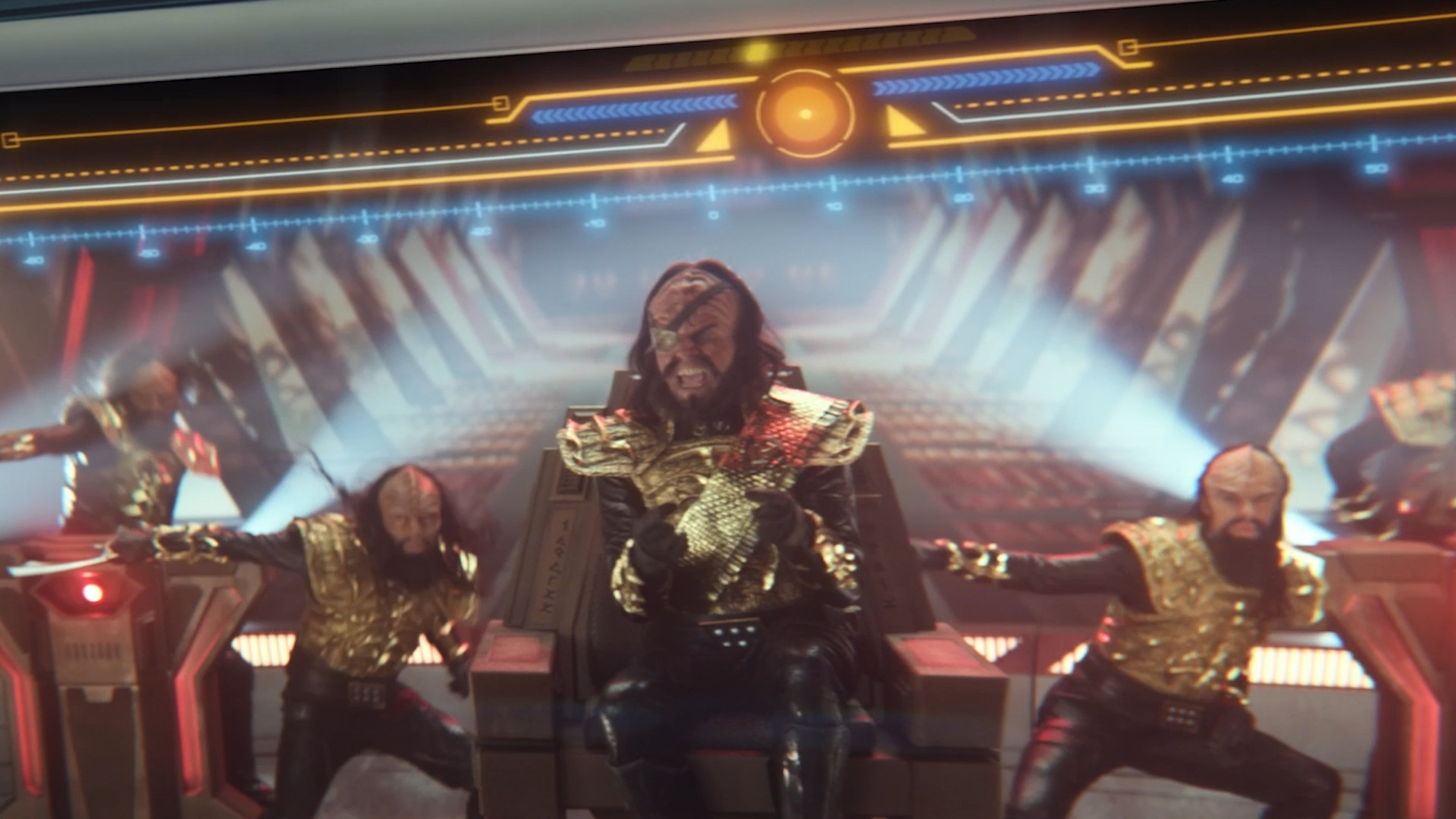
Earlier this year, Cinemablend asked Star Trek writer-producer Alex Kurtzman whether he thought that a modern Star Trek show could ever reach 100 episodes in the age of streaming. This was fairly standard for previous franchise entries that would later be syndicated to other networks, with The Next Generation, Deep Space Nine, and Voyager all broadcasting nearly 200 episodes across seven seasons—though poor, unloved Enterprise was cancelled just two episode before hitting triple figures (whether you think this is a tragedy probably depends on how recently you re-watched that prequel series).
Kurtzman, who has been a key creative figure in modern Trek since 2009’s J.J Abrams-directed big-screen reboot, said that hitting such a milestone in the era of streaming was “unlikely.” But he also suggested that this wasn’t necessarily a bad thing: “You can talk to old writers of old Trek series, and they’re like, ‘Man, there’s a bunch of filler episodes in there. We are just trying to get to 22 a season,’ you know … and we all know which of those episodes were [filler], we know the ones that were truly stellar from the ones that felt like they were kind of spinning their wheels.”
Regardless of one’s personal feelings about Kurtzman or his approach to Star Trek, his observations are not without merit. For such a beloved and influential franchise, televised Star Trek has historically had, to put it charitably, variable quality control. While a more conventional syndicated crime procedural from, say, the mid-’90s might never reach particularly mind-blowing heights, you could be pretty confident that an average episode would be competent and baseline watchable.
Not so with Star Trek. Tuning in to watch live in the ’80s, ’90s or even early 2000s, you truly had no idea what might be waiting for you. It could be a tense, exciting adventure. It could be thought-provoking, high-concept science fiction. It could be a poignant character piece, or a diverting bit of comedy fluff. It could conceivably be one of the worst episodes of television you would ever see in your life.
But what if that’s actually a good thing?
A Different Time
It’s important to put Kurtzman’s remarks in context. The current era of streaming TV is vastly different from that which produced the likes of TNG, DS9 and Voyager. In the ’80s and ’90s, US cable and broadcast networks wanted seasons of 22 episodes or more so that they would have enough content to pump into people’s living rooms between September and May, assuming that people watched less television during the summer. This nine-month period was in turn roughly split into a September-December block and a January-May block—hence the breaking up of TV shows into “seasons,” terminology that has since found its way over to the UK, even though our model for TV production is very different
It was also increasingly profitable for shows to be “syndicated,” i.e. sold to other networks in various different markets, both national and international. That’s why UK viewers were able to tune into TNG on BBC2 from September 1990, three years after the show’s US debut, a gap it’s pretty impossible to imagine fans putting up with these days. The more episodes available, the more valuable the package.
This is all a roundabout way of saying that the 22-episode season model was not one born out of an artistic or creative impulse. The motive was profit. After all, t paraphrase one of the Ferengi Rules of Acquisition, a production company without profit is no production company at all.
Of course, the streaming era is no different in that respect. The motive is the same, it’s only the model that has changed—in a world with so many more options for entertainment, competition for attention has become much more intense. And in this new landscape of increased competition and decreased attention spans, even a legacy brand like Star Trek can’t assume enough viewers to justify the cost of a 22-episode season—costs that would likely be prohibitive anyway, as most streaming services seem to be operating at a loss even now. Audiences are no longer limited to what happens to be showing on TV at a particular time of day, and a season of around 10 episodes has therefore become the ideal model, with creatives being forced to adapt as a result.
For Kurzman, this is ultimately a positive thing. It means 10 lean, focused episodes, where the excitement—and by extension the audience’s investment—is constantly maintained, and all the money is always on screen rather than stretched to breaking point. It means heavy serialization, story arcs, big action, and big emotions. No bottle episodes, obtuse chamber pieces, or quirky character experiments.
No “filler.”
The Joy of “Filler”
But Star Trek’s mission, famously, is “to explore strange new worlds, to seek out new life and new civilizations, to boldly go where no-one has gone before.” And longer seasons—while undoubtedly stressful for writers and prone to dramatic fluctuations in quality—are arguably a more comfortable fit for such a mission, because of the increased room for experimentation.
Kurtzman seems to be suggesting that without the requirement to fill a 22-episode season, the wheat is naturally going to be separated from the chaff, and only the truly great ideas will make it to screen. A sort of televisual survival of the fittest that will only ever produce episodes that really deserve to be seen, filtering out the odd ducks where the production team is “spinning its wheels.” But there’s no guarantee that lessening the quantity automatically improves the quality, and this approach risks throwing the baby out with the bathwater.
Would a more modern, 10-episode season of The Next Generation find space for stories like “The Inner Light,” the Hugo Award-winning season 5 episode in which Captain Picard experiences 40 years of life as an alien scientist? It’s a quiet, meditative, hugely poignant episode, with no battles and few flashy special effects. A streaming audience could conceivably be put off by its deliberate, thoughtful pace—but what a tragedy to potentially lose such a memorable, moving story, in service of such a risk-averse model.
What about “Data’s Day,” whose heavily comic A-plot focuses on the android Data’s confusion over human marriage rituals, with a political assassination consciously relegated to the B-plot? At best, you can imagine these two plots being reversed for a modern version, on the assumption that audiences will be more attracted to the thrilling political machinations. A beloved main character bumbling around, learning more about what it is to be human? Don’t waste my time.
Okay, two acknowledged classics there, of course it would be a shame to lose them. But what about acknowledged disasters? There are almost too many examples to list across TNG’s much maligned first couple of seasons. Would you really try to court a fickle streaming audience by subjecting them to season 1’s “Justice,” in which the reviled Wesley Crusher falls afoul of some cheerful, scantily clad hippies who happen to have the death penalty for minor acts of vandalism?
The thing is, while it’s hard to defend “Justice” on its own merits—it is, in a word, crap—in the broader context of Star Trek, it’s helpfully illustrative. The episode is trying, in its own half-baked and cringeworthy way, to show us a strange new world, and use that setting to generate a compelling moral dilemma. The execution is lacking, even by the standards of the time, let alone those of the modern era. But it’s far closer to the beating heart of Star Trek, to its true mission statement, than 50 minutes of exploding spaceships designed to distract someone from scrolling TikTok.
There’s also a reluctance here to embrace sillines—because old Trek was silly, and we don’t want to remind people of that, because it’s embarrassing. But silliness is part of Star Trek! It’s in its DNA. Even Deep Space Nine, which leaned much more heavily into serialization and moral ambiguity—and brought us one of Star Trek’s finest ever “filler” episodes in “Far Beyond the Stars”—knew when to give us a lighter, frothier instalment. The season 7 episode “Take Me Out to the Holosuite” took place right in the thick of the Dominion War, in which millions died and many ethical boundaries were crossed—and it was a perfect bit of low-stakes fun to break up the drama. In a 10-episode Dominion War season for the streaming era, there simply wouldn’t be time for Sisko to settle an old rivalry with a Vulcan captain via the medium of holographic baseball.
And that’s a terrible shame, because not everything has to be epic. Not everything has to be about destiny or intergalactic conspiracies or battles for the future of the universe or shouting. Sometimes it’s just nice to see characters we care about doing fun, silly, or interesting things, between exploring strange new worlds.
Speaking of which…
A Brighter Future
If there’s one modern Star Trek show that seems to appreciate this, it’s Strange New Worlds. The Discovery spin-off, following the adventures of Captain Pike and Mr. Spock on board a pre-Captain Kirk USS Enterprise, feels much closer to the spirit of older Trek, finding space between arc episodes and action thrillers for quirky character pieces like season 1’s “Spock Amok,” in which Spock switches bodies with his fiancé T’Pring, or season 2’s musical episode “Subspace Rhapsody.”
Are all these episodes completely successful? No. But they speak to a desire to grow, to explore, to experiment. To show us new settings, new dilemmas, new ideas. The kinds of stories that only Star Trek can tell.
It was only natural, when the 2009 movie reboot came out, that Star Trek would be re-tooled into something more action-packed, more straightforwardly thrilling. Even the TNG movies had already started to go that way. And in 2024, the time of slow-paced TV with silly foam foreheads is long gone.
But there are many different franchises that can indulge our appetite for space battles, chases, and fist fights, while only one can give us an annoying boy genius falling on some flowers and being condemned to death by scantily-clad space hippies.
Sorry, what was that? You want me to defend the TNG episode “Code of Honor” now?
Oh dear, is that the time? I must be going…
The post Modern Star Trek Needs to Bring Back ‘Filler’ Episodes appeared first on Den of Geek.






